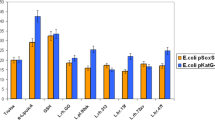Abstract.
A new rapid and sensitive method for the detection of antibacterial activities was based on luminescent indicator strains. Listeria innocua 8811 and Enterococcus faecalis 32 were transformed with plasmid carrying bacterial luciferase genes. Subsequent strains became capable to emit light during the exponential growth phase. The addition of bacteriocin containing culture supernatants to such cultures induced a drop of their light emission which was correlated to the combined antibacterial activity of acid stress and bacteriocin. The detection of antagonistic activity is independent of its mode of action, i.e. bactericidal or bacteriostatic. This method allowed to directly visualize the antagonistic activity of bacteriocin producer strains toward target strains in co-culture experiments. However, a control co-culture with non-producing bacteriocin mutant was necessary in order to distinguish between nutrients competition and bacteriocin activity. Finally, five class IIa bacteriocins were purified from culture supernatants of eight strains detected in 3 days from a 120 lactic acid bacteria collection.
Similar content being viewed by others
Author information
Authors and Affiliations
Additional information
Received revision: 30 August 2001
Electronic Publication
Rights and permissions
About this article
Cite this article
Simon, .L., Fremaux, .C., Cenatiempo, .Y. et al. Luminescent method for the detection of antibacterial activities. Appl Microbiol Biotechnol 57, 757–763 (2001). https://doi.org/10.1007/s00253-001-0833-3
Received:
Accepted:
Issue Date:
DOI: https://doi.org/10.1007/s00253-001-0833-3




